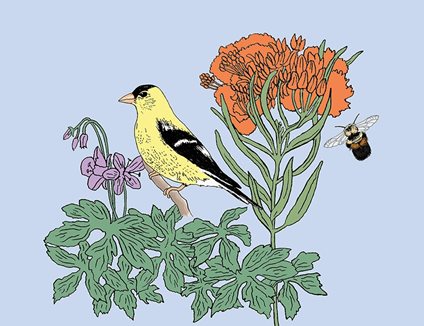Sustainable landscapes
As part of its mission to improve water quality and ensure a sustainable water supply for the region, Metropolitan Council Environmental Services is working to plant landscapes that need less water, reduce runoff, and provide habitat for birds, bees, and butterflies. Sustainable landscapes include drought-tolerant turf, bee lawn, and Minnesota native grasses, flowers, trees, and shrubs.

Resilient ecosystems beautify neighborhoods and protect clean water
Sustainable landscapes promote economic and environmental resiliency because they:
Conserve water and other resources – Drought-tolerant and native plants rarely need watering, mulching, fertilizing, or mowing once they are established.
Prevent water pollution – The long roots of native plants help to keep rainwater onsite and reduce polluted runoff flowing into local waterways.
Reduce flooding – Trees and native plants soak up the rain and reduce the amount of water flowing into the street and stormwater system.
Improve resiliency – Sustainable landscapes help communities become more resilient by reducing flood risk, preparing for drought, reducing heat island effects, and preventing erosion.
Increase biodiversity – Trees, grasses, and flowering perennials—especially native plants—create habitat, and provide nectar, pollen, and seeds for butterflies, birds, and other animals.
Beautify neighborhoods – Sustainable landscapes provide an opportunity to view wildlife and native flowers.
Timeline for sustainable landscape development
Cultivating a sustainable landscape with native plants takes a few years. While the site may look undeveloped for the first couple of years, we will proactively manage weeds and invasives as plants become established. Please do not mow, spray, or walk on the property. This can damage the maturing landscape.
Year 1: SLEEPS - Initial site planting. Invasives are removed. Site looks undeveloped.
Year 2: CREEPS - Small plants emerge and are vulnerable to damage. Site looks undeveloped.
Year 3: SWEEPS - Plants become identifiable and grow in patchy clusters. Site starts to establish.
Year 4: LEAPS - Plants mature and become self-sustaining. Site looks like a natural area.
What neighbors can expect
The Met Council is committed to being a good neighbor. As we work to convert our properties to sustainable landscapes, you will see us removing invasive plants and trees, prepping the site for plantings, mowing occasionally, and doing other landscaping work.
Thoughtful design – We have engaged skilled landscape architects and landscaping contractors that specialize in sustainable landscapes to design and install a landscape well-suited to the site, neighborhood, and local environment.
Timely communication – If you live near a sustainable landscape restoration project, we will let you know about activities planned near you by mail, email, or posted signs. We will respond quickly to messages received by email and on our project phone line.
Considerate installation – We will do our best to minimize negative impacts to the neighborhood, however there may be some noise during business hours and we may use and store large equipment on the property.
Ongoing care and maintenance –The landscape will look sparse and undeveloped for a few years as plants get established. During that time, we will maintain some areas to a height of six inches, but plants may grow up to 12 inches. Once landscapes become established, we will continue maintenance by mowing designated areas and treating and removing invasive plants.
Project Locations
Project Staff
Project Managers:
Dawn Pfarr, Project Coordinator, Interceptor Engineering
Michael Villari, Principal Engineer, Interceptor Engineering
Project Contacts
For assistance, call | Si necesita ayuda, llame al | Xav tau kev pab, hu | Wixii kaalmo ah, ka wac | Để được hỗ trợ, hãy gọi | လၢတၢ်ဃ့န့ၢ်တၢ်မၤစၢၤအဂီၢ, ကိးဘၣ်ဖဲ | 651-760-0075.
For the Rosemount L75 site, contact:
For the Bayport, Brooklyn Park, Eden Prairie, and Mound sites, contact: